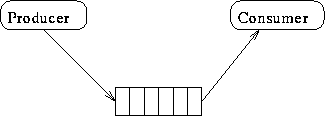
- Producer and Consumer work at different rates.
- Fixed amount of buffering (queuing) between them.
- With no synchronization, items can ``disappear'' or be multiply
consumed.
- Lock and condition variables.
- A thread must secure the lock before executing within the
monitor.
- Once in the monitor, a thread checks its condition variables:
- Producer: queue full.
- Consumer: queue empty.
- Producer: queue full.
- Once a thread has modified state within the monitor, it will
notify waiting threads, allowing them to recheck their conditions.
(Must first re-obtain lock.)
class Queue
{
private int val;
private boolean full = false;
private boolean empty = true;
public Queue()
{
val = 0;
}
public synchronized void put(int v)
{
while (full)
try
{
wait();
}
catch (Exception e)
{
}
val = v;
full = true;
empty = false;
notify();
}
public synchronized int get()
{
while (empty)
try
{
wait();
}
catch (Exception e)
{
}
full = false;
empty = true;
notify();
return val;
}
}